Key takeaways:
- Blue-green deployments reduce downtime and improve the reliability of application updates by allowing seamless switching between environments.
- User feedback can be efficiently gathered by running new versions in parallel with the old ones, enhancing responsiveness to user needs.
- Tools like AWS Elastic Beanstalk, Terraform, and Kubernetes significantly facilitate the setup and management of blue-green deployments.
- Challenges include managing multiple environments, ensuring data synchronization, and the necessity of robust monitoring to avoid potential issues during deployments.
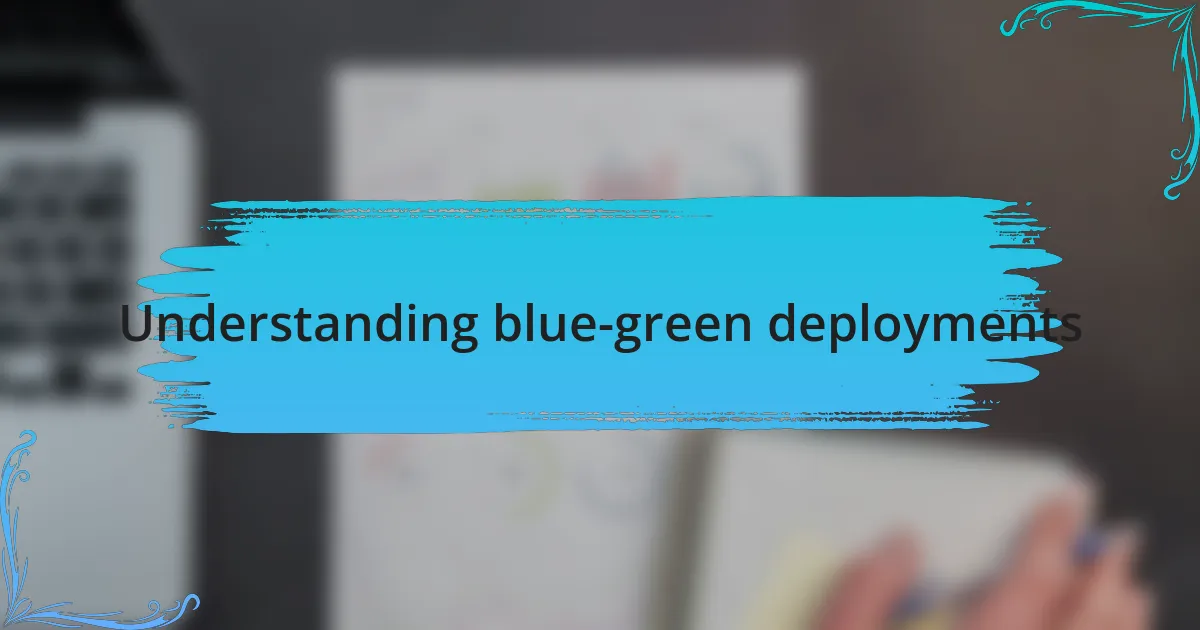
Understanding blue-green deployments
Blue-green deployments are a strategy I’ve found invaluable in managing application updates. Essentially, you have two identical production environments—one live (the blue) and one for staging (the green). When I first encountered this technique, I marveled at how it reduces downtime. Isn’t it great to think you can switch traffic seamlessly from one version of your app to another?
The magic of blue-green deployments lies in their ability to mitigate risks during software updates. I remember a project launch where we employed this method. We could test the new features on the green environment without affecting our users on the blue side. This safety net gave us the confidence to innovate without the usual anxiety—doesn’t that sound liberating?
What’s more, rolling back to a previous version becomes a breeze with blue-green deployments. Instead of worrying about complicated undo processes, I simply switched the routing back to the blue environment, reinstituting stability. Wouldn’t you feel relieved knowing you have that kind of safety in your deployment strategy? This approach not only enhances reliability but also allows for a more agile development process.
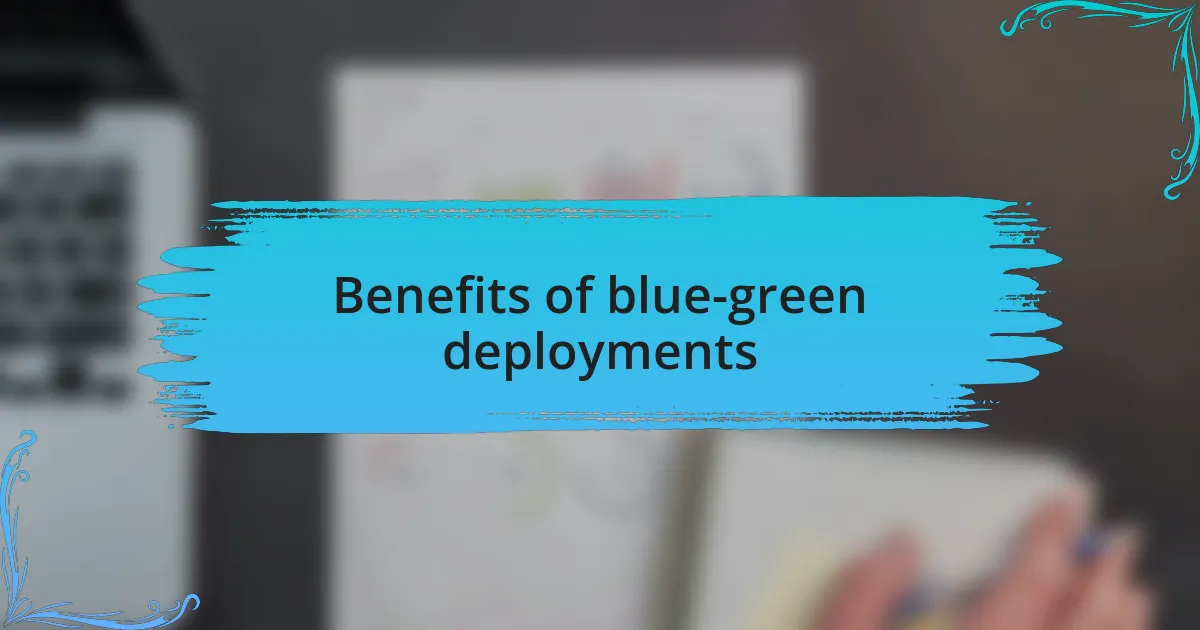
Benefits of blue-green deployments
One of the standout benefits I’ve experienced with blue-green deployments is the remarkable reduction in downtime during updates. In a previous project, we rolled out a critical feature with minimal interruption to our users. The transition was so smooth that I barely had time to brace myself for potential issues—but there were none! Isn’t it reassuring to know that your users can continue enjoying a seamless experience while you deploy changes behind the scenes?
Another significant advantage is user feedback. By running the new version alongside the old one, I gather insights that truly matter. I recall a scenario where we released a new UI on green; collecting user reactions was straightforward and immediate. Seeing real-time responses and being able to iterate quickly felt invigorating. Isn’t it powerful to have that level of engagement and responsiveness?
The confidence boost that comes from having a reliable fallback cannot be overstated. During one deployment, a bug in the green environment emerged just as we were about to switch traffic. The ability to revert to blue in seconds felt like a safety net made of steel. This not only calmed my nerves but also reinforced the trust our team placed in this deployment strategy. Wouldn’t you agree that having that level of control allows for more daring innovations?
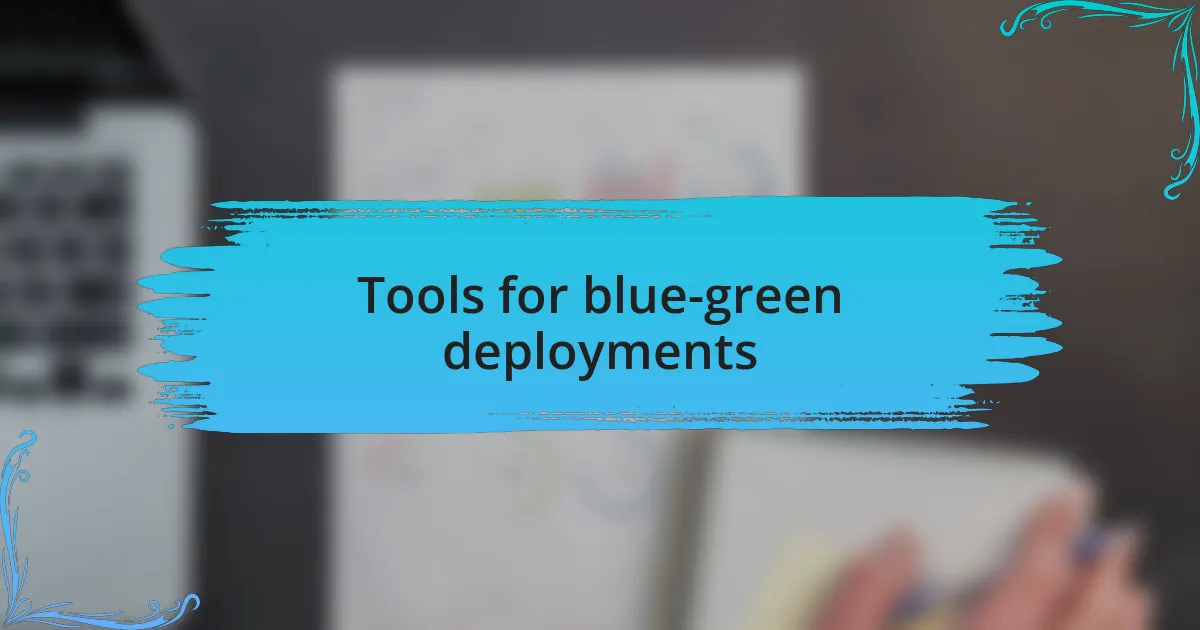
Tools for blue-green deployments
Tools play an essential role in facilitating blue-green deployments, making the process more efficient and reliable. In my experience, platforms like AWS Elastic Beanstalk have been invaluable. With a few clicks, I could set up two identical environments and easily shift traffic between them, which relieved so much of the stress that often accompanies deployment.
Another tool that has proved exceptionally helpful is Terraform. Using it allowed me to automate the process of managing environments consistently. I remember a project where I had to switch environments rapidly due to an unforeseen issue in production. Thanks to Terraform, I could recreate my blue environment with precision, saving precious time and ensuring developers could quickly refocus their efforts.
I’ve also found Kubernetes to be a game-changer when it comes to orchestrating blue-green deployments. Its ability to manage container transitions seamlessly has empowered my team to innovate without fear. Imagine deploying a new version of your application and knowing that, if a problem arises, you have the control to roll back effortlessly. Isn’t it liberating to rely on tools that offer such a high level of confidence in your deployment process?
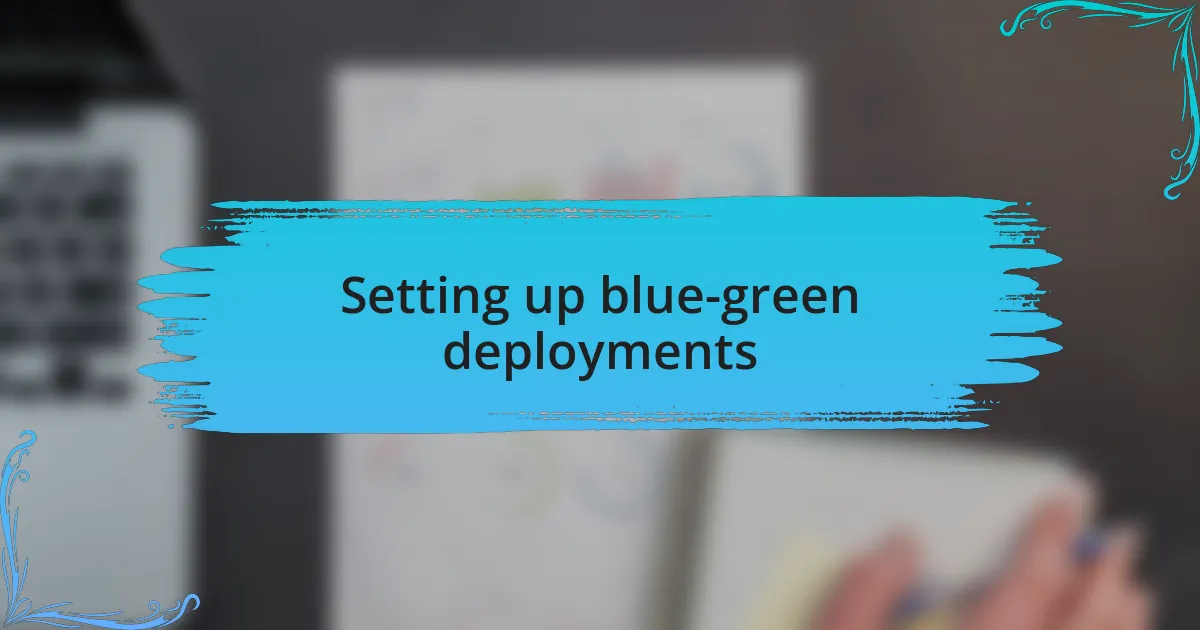
Setting up blue-green deployments
Setting up blue-green deployments is all about having a structured approach that minimizes downtime and maximizes efficiency. From my experience, I found it crucial to begin by creating two identical environments—this offers a safety net during deployments. The first time I did this, I felt a wave of relief knowing that if anything went wrong, I had a backup ready to go without any panic.
Once the environments were in place, I focused on streamlining the traffic routing process. I vividly recall working late into the night to configure the load balancer for a major release. It felt like a huge responsibility, one that could impact users if not done right. However, when I finally switched the traffic to the new version and watched it run smoothly, I thought, “This is why I put in the effort.” The thrill of knowing that users were experiencing the latest features without missing a beat was exhilarating.
Monitoring became my next priority. After the deployment, keeping an eye on metrics and logs was essential. I remember a deployment where I caught a minor performance hiccup early on just by monitoring the blue environment’s metrics. This proactive approach allowed me to address issues before they escalated, reinforcing my belief that a good setup isn’t just about the initial deployment—it’s about the ongoing vigilance that ensures everything stays on track.

Best practices for blue-green deployments
When implementing blue-green deployments, one of the best practices I’ve learned is to automate the deployment process as much as possible. I recall a time when I relied too heavily on manual steps, leading to unexpected errors. Automation alleviated that stress, allowing my team to push updates quickly and confidently without worrying about human error. It’s truly liberating to see everything work seamlessly after hitting that deploy button.
Another key point is to ensure thorough testing before switching traffic to the new version. I remember a deployment where we skipped a few automated tests to save time. It turned out to be a huge mistake; minor bugs slipped through, disrupting user experience shortly after launch. Testing isn’t just a checkbox; it’s your safety net. I always ask myself, “Would I feel comfortable using this version if I were a user?” That perspective shifts everything in favor of thoroughness.
Finally, I recommend implementing a rollback plan that can be executed quickly if necessary. There’s an undeniable sense of anxiety when deploying something new, and my first experience of needing to roll back taught me that having a clear, documented plan is essential. The lesson was clear: the deployment process can be smooth, but unexpected issues can arise. Being prepared makes all the difference, turning a potentially stressful situation into a simple recovery process. How reassuring it feels to navigate those waters, knowing there’s a plan in place!
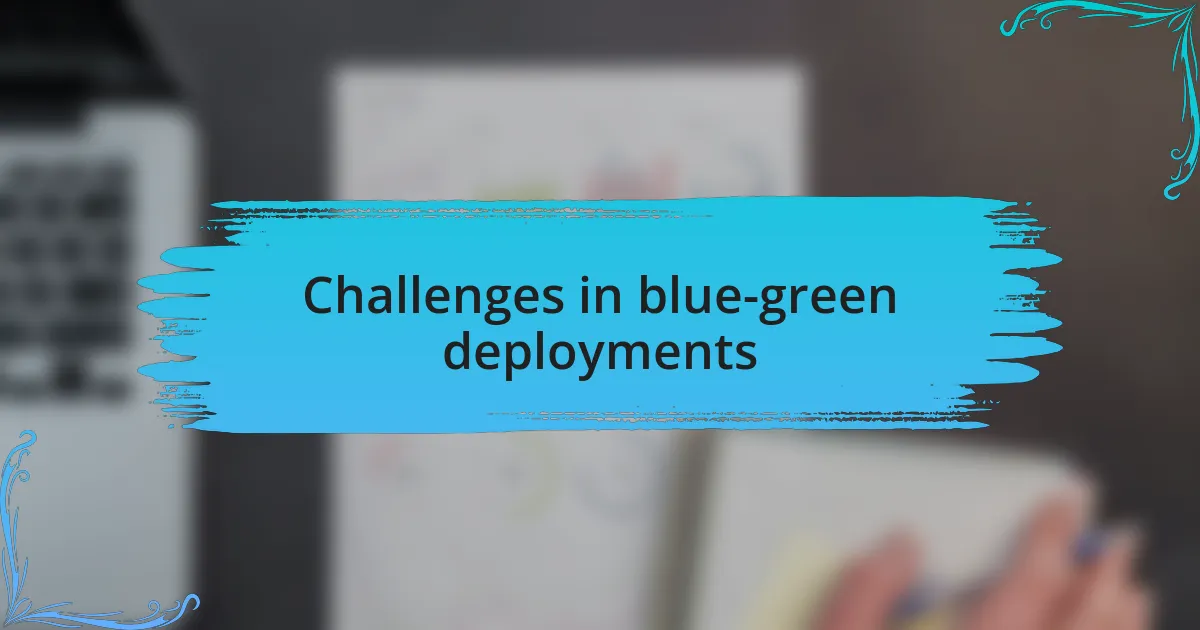
Challenges in blue-green deployments
When it comes to blue-green deployments, one challenge that often arises is the complexity of managing multiple environments. I recall a time when I had to juggle both the blue and green setups in different cloud providers. It became quite a feat, as ensuring consistency between the two environments required constant vigilance. How often do we underestimate the impact of environment discrepancies?
Another challenge is the potential for data synchronization issues. I’ve faced scenarios where our new version needed access to a database while users were still interacting with the old version. This led to data inconsistencies that we hadn’t anticipated, and I wondered how we could have better prepared for it. Having robust data migration and synchronization strategies is more than crucial; it’s paramount for maintaining a seamless user experience.
Additionally, monitoring and observability can quickly become overwhelming with blue-green deployments. There was a time when I forgot to set up adequate monitoring for the new version after a switch. It was a nerve-wracking experience waiting for feedback to confirm everything was functioning as intended. I learned that having real-time insights into both environments isn’t just helpful; it’s a necessity to identify issues before they escalate. How prepared are we really to catch those potential pitfalls?
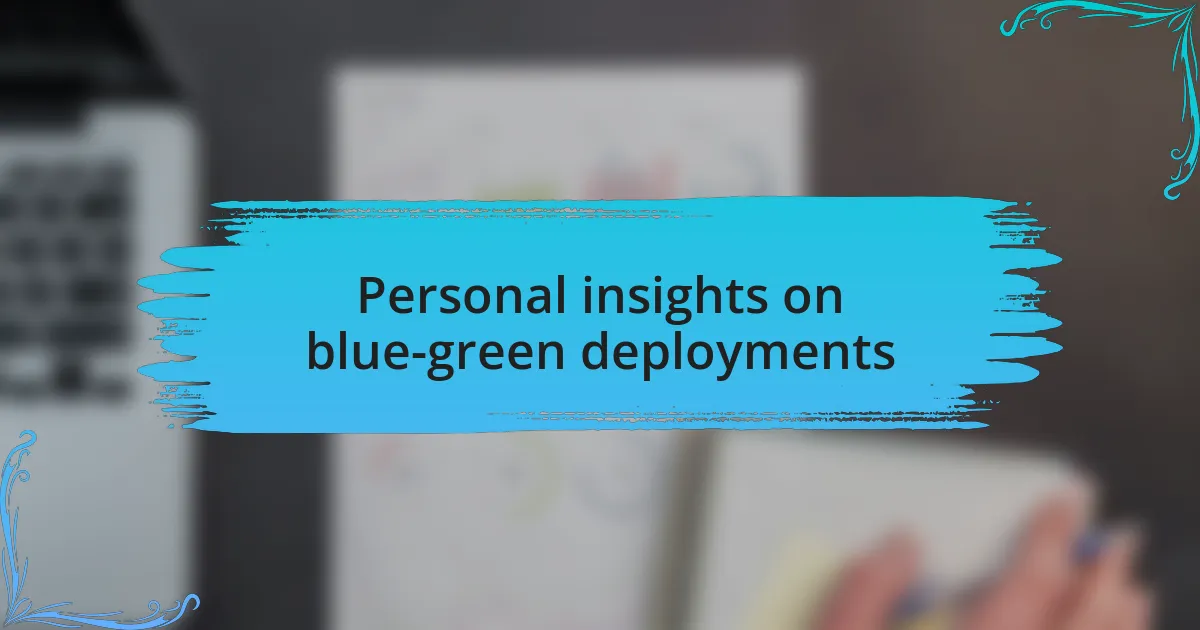
Personal insights on blue-green deployments
In my experience, one of the most rewarding aspects of blue-green deployments is the ability to perform quick rollbacks if something goes wrong. I remember the first time I had to revert a problematic update; it felt like a lifeline. The ease of switching back to the stable version gave me a newfound appreciation for this deployment strategy. It’s fascinating to think—how often do we get that kind of safety net in app deployment?
I’ve also discovered that clear communication among team members is essential during the transition process. I once underestimated the power of syncing my team on deployment timings and potential risks. When we all align on the same page, not only does it reduce anxiety, but it also fosters a culture of collaboration. Have you ever noticed how effective teamwork can elevate even the most intricate processes?
Another insight that stands out is the importance of user acceptance testing in the blue-green deployment process. I recall when we neglected this step and ended up receiving feedback that was less than favorable. The experience taught me that involving user perspectives early on significantly enhances the final outcome. How often do we overlook the end users in the rush to implement new features?